Vocking B., Alt H., Dietzfelbinger M., Reischuk R., Scheideler C., Vollmer H., Wagner D. Algorithms Unplugged
Подождите немного. Документ загружается.

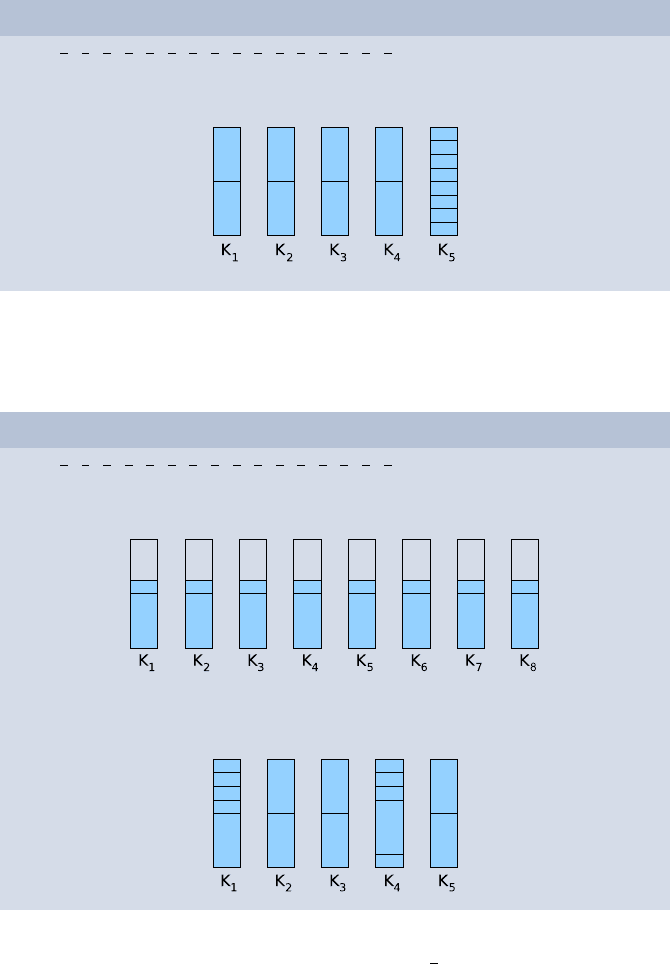
370 Joachim Gehweiler and Friedhelm Meyer auf der Heide
Example 2
G =
1
2
,
1
2
,
1
2
,
1
2
,
1
2
,
1
2
,
1
2
,
1
2
,
1
8
,
1
8
,
1
8
,
1
8
,
1
8
,
1
8
,
1
8
,
1
8
NextFit = FirstFit: n =5
But Example 3 illustrates that the order of the objects can influence the result
– algorithm NextFit performs rather poorly here:
Example 3
G =
1
2
,
1
8
,
1
2
,
1
8
,
1
2
,
1
8
,
1
2
,
1
8
,
1
2
,
1
8
,
1
2
,
1
8
,
1
2
,
1
8
,
1
2
,
1
8
NextFit: n =8
FirstFit: n =5
If one chooses a much smaller number than
1
8
for the sizes of the small
objects in Example 3, the unused space in each box grows to almost half
of the size of the box when using NextFit, i.e., in a worst-case scenario
NextFit would need almost double the amount of boxes compared to an
optimal packing.
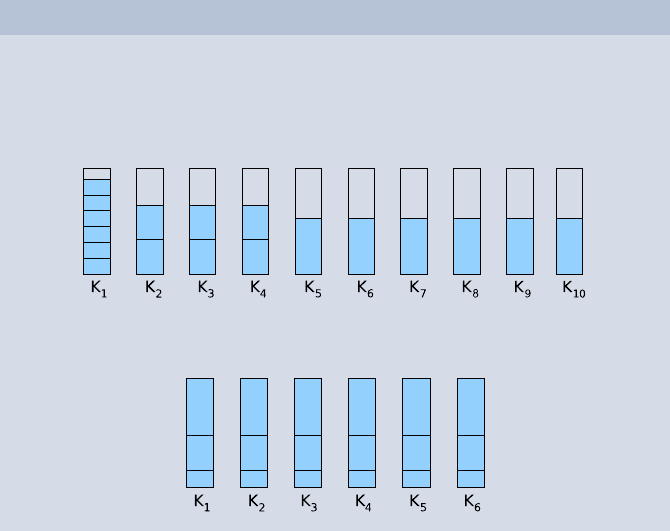
38 Bin Packing 371
Although strategy FirstFit has still performed optimally in Example 3,
there are also bad inputs for FirstFit, as shown in Example 4:
Example 4
G =(0.15, 0.15, 0.15, 0.15, 0.15, 0.15,
0.34, 0.34, 0.34, 0.34, 0.34, 0.34,
0.51, 0.51, 0.51, 0.51, 0.51, 0.51)
FirstFit: n =10
Optimal: n =6
Here we obtain a ratio of 10 : 6 for FirstFit compared to the optimal
packing, i.e., FirstFit needs 1.67 times as many boxes as an optimal algo-
rithm would require.
Now we are curious whether or not the negative examples 3 and 4 are
already the worst possible inputs for NextFit and FirstFit:
In Chap. 37 we learned that we call an online strategy α-competitive if it
does not produce – for any input – more than α times the cost compared to
an optimal solution, i.e., compared to the cost we would have produced if we
knew the future. In order to determine the competitive factor of NextFit,we
denote the number of objects by k and the number of boxes used by NextFit
by n. Furthermore, we write v(G
i
) for the volume of object G
i
and v(K
j
)for
the volume used in box K
j
. When now considering two successively filled
boxes K
j
and K
j+1
,1≤ j<n,itholds:
v(K
j
)+v(K
j+1
) > 1.
If this condition was not satisfied, all objects in K
j+1
would still have fit into
K
j
and would thus not have been put into K
j+1
by NextFit.Now,when
adding the volumes used in K
1
and K
2
,inK
3
and K
4
,inK
5
and K
6
,andso
on, we notice that all these sums are always greater than 1. Thus, we get for
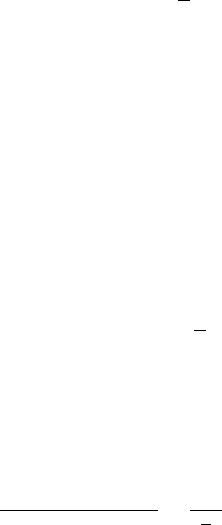
372 Joachim Gehweiler and Friedhelm Meyer auf der Heide
the sum over all boxes:
n
j=1
v(K
j
) >
n
2
.
Using the floor function we round down the fraction on the right-hand side
of the inequality in the case that n is odd. Hence, we obtain a lower bound
for the number of required boxes, i.e., a value that cannot be undercut even
with an optimal packing. Now we observe that the total volume of all objects
is equal to the volume totally occupied in all boxes:
k
i=1
v(G
i
)=
n
j=1
v(K
j
).
Thus, even the best possible packing requires at least
k
i=1
v(G
i
)
≥
n
2
boxes, due to the total volume of the objects. The volume of the objects has
to be round up here, because the number of the boxes has to be an integer.
Hence, we obtain for the ratio of the number of boxes required by NextFit
to the number of boxes required for an optimal packing:
solution NextFit
optimal solution
=
n
n
2
≤ 2.
Thus the online algorithm NextFit is 2-competitive (see introduction to on-
line algorithms, Chap. 37). As this proof can be transferred to FirstFit,
it is 2-competitive as well. It is possible to show that FirstFit is even
1.7-competitive, using a much more complicated proof (which we won’t exer-
cise here, see Further Reading).
How Well Can Online Algorithms for Bin Packing
Perform?
We now know lower bounds for the approximation quality of NextFit and
FirstFit, and we know that there are input sequences for which these bounds
are almost reached, i.e., for which the results cost almost twice (for NextFit)
and 1.7 times, respectively, (for FirstFit) as much as an optimal solution.
On the one hand, this is a good result as we know that the wasted space in the
boxes never exceeds a certain factor. But on the other hand, this result still
is somehow unsatisfactory because you sorely feel it in your budget if moving
costs 2000 Euro (or 1700 Euro, respectively) instead of 1000 Euro.
To finally judge how well or how poorly a strategy really performs, we
also have to take into account how well any online algorithm for bin packing

38 Bin Packing 373
can perform at all. Since the input sequence is not known in advance, it
somehow seems impossible to design an online algorithm which always outputs
an optimal result. We’re now going to prove this fact.
Suppose we have an input sequence which contains 2·x objects of size
1
2
−ε,
where x is a positive integer and ε is an arbitrarily small, positive number. The
optimal packing for this input sequence obviously is: x boxes which contain
2 objects each. Let’s now consider an arbitrary online algorithm and denote
it by BinPac. BinPac will spread the 2 · x objects over the boxes so that –
depending on the strategy – each box either contains one or two objects. We
denote the number of boxes containing one object by b
1
, and those containing
two objects by b
2
.Byb = b
1
+ b
2
we denote the total number of boxes used
by BinPac. Then we can find this correlation:
b
1
+2· b
2
=2·x ⇒ b
1
=2·x − 2 · b
2
.
By inserting this into b = b
1
+ b
2
we get:
b =(2·x − 2 · b
2
)+b
2
=2·x − b
2
. (38.1)
We’ll get back to this intermediate result later. Now let’s check what happens
if our input sequence consists of 4 · x objects, in which the first 2 · x objects
again have size
1
2
−ε and the remaining 2·x size
1
2
+ε. Since online algorithms
generally cannot look into the future, BinPac will behave on the first 2 · x
smaller objects the same way as in the previous example, where no further
objects were following. Thus, when placing the remaining objects of size
1
2
+ε,
we can first fill up the b
1
many boxes with one object, and then we’ll have to
open a new box for each of the remaining 2 · x − b
1
objects. Hence, BinPac
at least needs
b +(2· x − b
1
)=(b
1
+ b
2
)+(2· x − b
1
)=2·x + b
2
(38.2)
boxes for this input sequence in total. But the optimal solution would have
been to put one of the smaller and one of the bigger objects in each box,
leading to a total of only 2 · x required boxes.
Now we are ready to prove that no online algorithm is better than
4
3
-competitive. We argue by first assuming that there would be a better online
algorithm and then showing that this assumption leads to a contradiction.
Suppose BinPac would be better than
4
3
-competitive. Then the number
of boxes used for the first input sequence would have to be strictly less than
4
3
times the number of boxes required for an optimal solution. Formally:
b<
4
3
· x.
Applying this to (38.1), we get:
2 · x − b
2
<
4
3
· x ⇒ b
2
>
2
3
· x. (38.3)
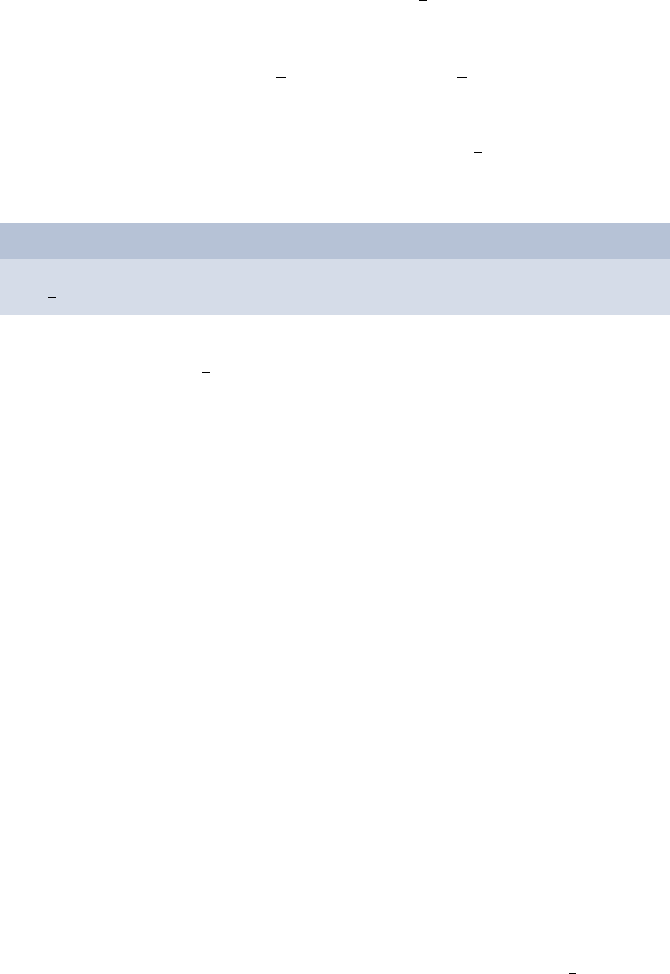
374 Joachim Gehweiler and Friedhelm Meyer auf der Heide
Analogously, for the second input sequence, we perceive that the number of
the boxes used (see (38.2)) is strictly less than
4
3
times the number of boxes
required for an optimal solution (2 · x). Formally:
2 · x + b
2
<
4
3
(2 · x) ⇒ b
2
<
2
3
· x. (38.4)
Now we end up in a contradiction because, as of (38.3)and(38.4), b
2
would
have to be both strictly less and strictly greater than
2
3
· x at the same time,
which is impossible. Thus, our assumption must have been wrong, and we
have proven:
Theorem 1
There is no α-competitive online algorithm for the bin packing problem with
α<
4
3
.
Now, knowing that even the best possible online strategy for bin packing
cannot be better than
4
3
-competitive, the 1.7-competitive strategy FirstFit
appears in a much more positive light. Okay, people, let’s get packing!
A further application for bin packing is, for example, to assign files to CDs
when backing up a huge amount of data. In this case, the above-described
strategies can even be applied directly, i.e., we don’t have to make simplify-
ing assumptions as there is no “clipping” problem when dealing with (one-
dimensional) data streams.
Further Reading
1. http://www-cg-hci-f.informatik.uni-oldenburg.de/
∼
da/iva/baer/
start/bin1.html
This Java applet interactively illustrates how the FirstFit algorithm
works.
2. D. Johnson: Fast algorithms for bin packing. Journal of Computer and
System Sciences 8 (1974), pp. 272–314.
This is the first publication on online bin packing.
3. S. Seiden: On the online bin packing problem.In:Proceedings of the
28th International Colloquium on Automata, Languages and Program-
ming (July 2001), Springer, pp. 237–249.
The best algorithm for online bin packing known so far (Harmonic++),
which is 1.58889-competitive, is introduced in this article.
4. A. van Vliet: An improved lower bound for online bin packing algorithms.
Information Processing Letters 43, 5 (October 1992), pp. 277–284.
In this article the value for α in Theorem 1 is improved from
4
3
to 1.5401.

39
The Knapsack Problem
Rene Beier and Berthold V¨ocking
Max-Planck-Institut f¨ur Informatik, Saarbr¨ucken, Germany
RWTH Aachen, Aachen, Germany
In two months, the next rocket will leave Earth heading to the space station.
The space agency, being a little short of money, offers to carry out scientific
experiments for other research institutions at the space station. For each ex-
periment, some equipment needs to be lifted up to the station. However, there
is a limit on the weight the rocket can carry. Apart from the obligatory food
rations, the rocket is able to carry up to 645 kg of scientific equipment. The
space agency receives several offers from different research institutions stating
how much they are willing to pay for the execution of an experiment and
specifying the weight of the necessary equipment. The space agency wants to
figure out which of these experiments should be chosen in order to maximize
the profit.
This scenario exemplifies a classic optimization problem, the so-called
knapsack problem: Suppose we have a knapsack that has a certain capac-
ity described by a weight threshold T .Wearegivenasetofn items, each
bearing a weight and a profit. The task is to choose a subset of the items that
should go into the knapsack. Only subsets of total weight at most T can be
chosen. The objective is to make the profit as large as possible. That is, one
seeks for a subset such that the sum of the profits of the items in the subset is
as large as possible under the constraint that the sum of the weights of these
items is at most T .
In the introductory example the knapsack corresponds to the rocket. The
weight threshold is T = 645. The items correspond to the experiments. To
make the example more concrete we assume that the space agency can choose
from n = 8 experiments listed with the following weights and profits.
Item 12345678
Weight in kg 153 54 191 66 239 137 148 249
Profit in 1000 Euro 232 73 201 50 141 79 48 38
Profit density 1.52 1.35 1.05 0.76 0.59 0.58 0.32 0.15
B. V¨ocking et al. (eds.), Algorithms Unplugged,
DOI 10.1007/978-3-642-15328-0
39,
c
Springer-Verlag Berlin Heidelberg 2011
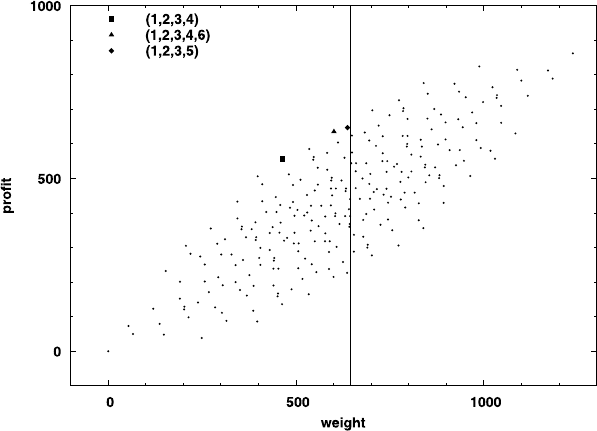
376 Rene Beier and Berthold V¨ocking
How can we find a feasible set of items that maximizes the profit? Intu-
itively we could choose those items first that achieve the largest profit per
unit weight. This ratio between profit and weight is called profit density. We
have calculated the profit density for all items. The table lists the items from
left to right in such a way that this ratio is decreasing.
Our first algorithm follows the idea above and sorts all items by decreasing
profit density, e.g., by using the algorithms from Chap. 2 or Chap. 3. Starting
with the empty knapsack we add items one by one in this order as long as
the capacity of the knapsack is not exceeded. In our example, we would pack
items 1, 2, 3, and 4 as their cumulative weight is 464, which is still below the
threshold. Adding item 5 would result in a total weight of 464 + 239 = 703,
which would overload the knapsack. The four packed items yield a profit of
556. Is this the maximal profit that we can achieve? Not quite. By adding
item 6 we obtain a knapsack packing with a total weight of 601 that is still
feasible and has a total profit of 635. Is this now the most profitable subset?
Unfortunately not.
Of course, in order to guarantee optimality we could test all possible com-
binations of packing the knapsack. To better illustrate let us draw all possible
packings in a weight–profit diagram, irrespective of the weight threshold. For
instance, we draw the point (601, 647) for the packing with items {1, 2, 3, 4, 6}.
Each point represents a subset of items. How many points do we have to
draw? We must decide whether to include each item or not; hence there are
two possibilities per item. As the choice for each item is independent from
the choice made for the other items, there are 2
n
possibilities for n items.
Thus, in our example, we would need to test 2
8
= 256 different packings.
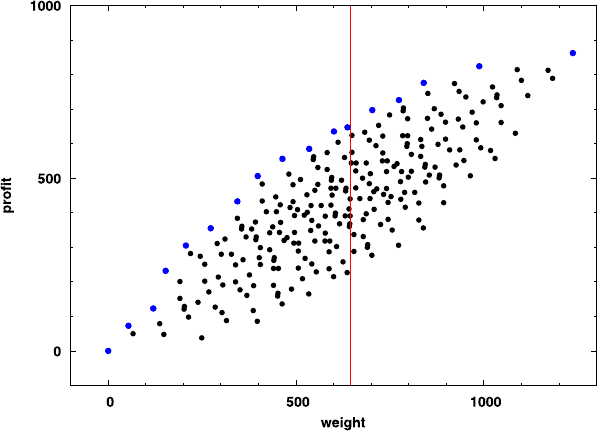
39 The Knapsack Problem 377
The packings with weights greater than the threshold T are not feasible.
These subsets correspond to points in the diagram that lie to the right of the
vertical line. Points to the left of or exactly on the vertical line correspond
to feasible packings. Among those feasible packings we choose the one with
maximum profit. In our example, it is the point with coordinates 637 and
647, corresponding to the packing containing items 1, 2, 3, and 5. This is the
optimal solution.
This approach of finding the best solution is practical only for a small
number of items as the computational effort increases rapidly when increasing
the number of items. Each additional item doubles the number of packings
that need to be tested. When the space agency, for example, can choose among
60 experiments the number of possible packings grows to
2
60
=1,152,921,504,606,846,976.
Assuming that a modern computer can test 1,000,000,000 packings per
second, it would still take more than 36 years to finish the computation. Of
course, we do not want to delay the start of the rocket for such a long time.
Pareto-Optimal Solutions
How can we find the optimal solution faster? The key to a more efficient
algorithm is the following observation: A packing cannot be optimal if there
exists another packing with lower weight and higher profit. Let’s go back to
our example.
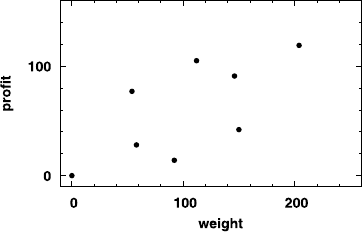
378 Rene Beier and Berthold V¨ocking
None of the black points can be the optimal solution since for each of
them we can find at least one other point that is better, i.e., that has both
lower weight and higher profit. We say that this better point dominates the
black point. The blue points in the diagram are exactly those points that are
not dominated by any other point. These points are called Pareto-optimal.
Hence, a packing is Pareto-optimal if there exists no other packing of less
weight that yields a higher profit. In our example, only 17 of the 256 packings
are Pareto-optimal. The optimal solution must be among those 17 packings.
Observe that the property of being Pareto-optimal is independent of the choice
of the weight threshold. In particular, for any given threshold we can find the
optimal solution among those 17 packings.
So far we have ignored in the discussion the fact that two packings can
have the same weight or the same profit. In order to correctly handle those
cases we define that packing A dominates packing B if A is at least as good
as B in weight and in profit and additionally if A is strictly better than B in
at least one of the two criteria.
But how can we compute a list of all Pareto-optimal packings efficiently,
namely without testing all 2
n
packings? Consider the following small example
starting with three items. We plotted all 2
3
= 8 different packings in a weight–
profit diagram.
Let us assume that we know the set of Pareto-optimal packings for these
three items, and we consider an additional fourth item. For each of the eight
packings we can generate a new packing by adding the fourth item. This way,
we obtain eight additional packings. Each black point generates a new red
point with a horizontal and vertical shift corresponding to the weight and
profit of the fourth item. Hence, the set of red points is just a shifted copy of
the set of black points.
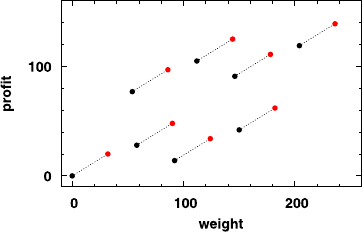
39 The Knapsack Problem 379
What can we say about the Pareto-optimality of these 16 points? We
exploit that we already know the set of Pareto-optimal packings for three
items. A black point dominated by some other black point is by definition
not Pareto-optimal. The same holds for each red point dominated by some
other red point. In other words, a black point that is not Pareto-optimal with
respect to the black point set (3 items) cannot become Pareto-optimal with
respect to all 16 points (4 items). The same applies to red points that are
not Pareto-optimal with respect to the red-point set. As a consequence, only
points from the following two sets can potentially be Pareto-optimal.
A: black points that are Pareto-optimal with respect to the black point set,
and
B: red points that are Pareto-optimal with respect to the red point set.
Observe that the points in B are just shifted copies of the points in A.Now
consider a point p from A. Suppose p is dominated by a red point q.Ifq does
not belong to B then there must be a red point q
in B that dominates q and
thus dominates p as well. Hence, in order to check the Pareto-optimality of a
point from A (with respect to both black and red points), one only needs to
check if this point is not dominated by a point from B. Analogously, in order
to check the Pareto-optimality of a point from B, one only needs to check if
it is not dominated by a point from A.
Now we have a procedure for computing the set of Pareto-optimal pack-
ings when adding one additional item: First construct all red points that are
generated from Pareto-optimal black points. Then delete all red points dom-
inated by a black point. Finally, delete all black points dominated by a red
point.
The Nemhauser–Ullmann Algorithm
The following algorithm was invented by Nemhauser and Ullmann in 1969. It
uses the arguments above in an iterative fashion, adding one item after the
other. That is, it starts with the empty set of items and adds items one by
one until it finally obtains the set of Pareto-optimal packings for all n items.
